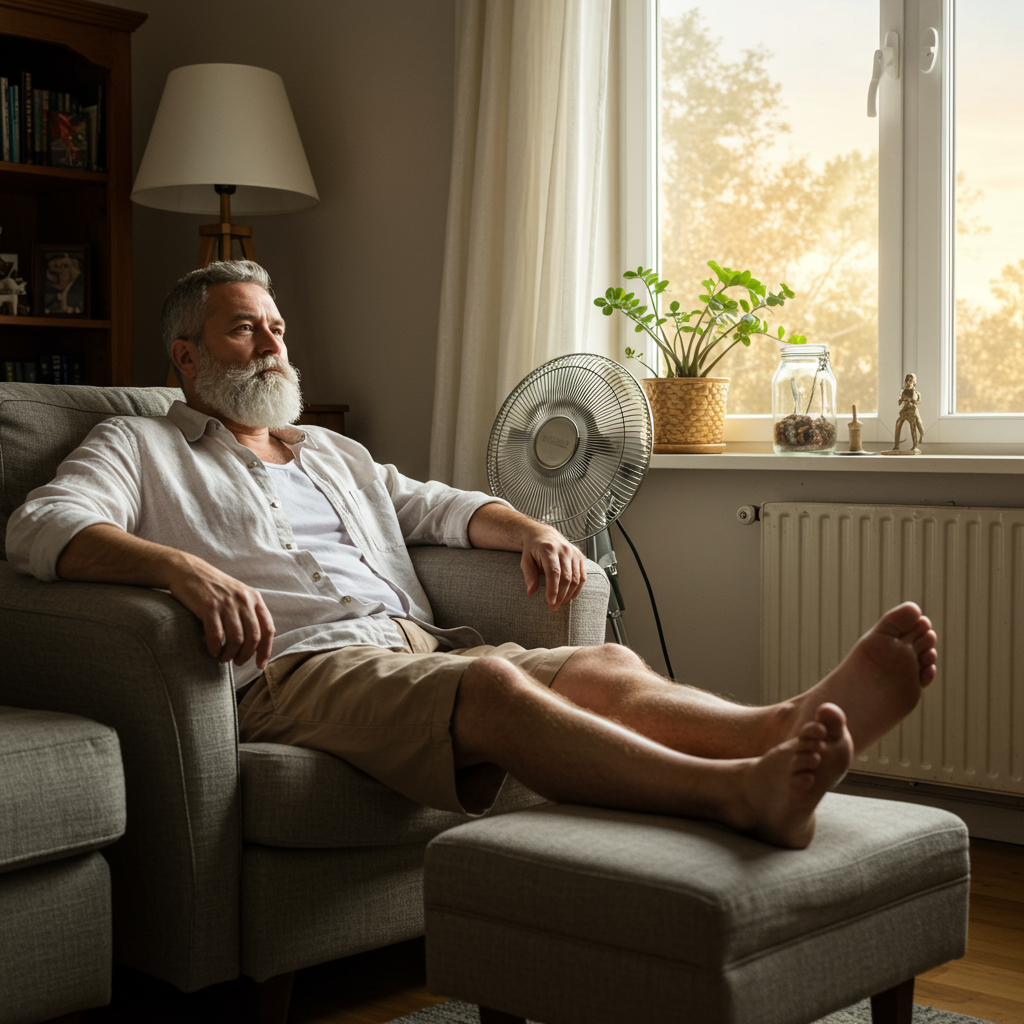When temperatures rise, staying cool becomes more than just a matter of comfort – it’s essential for health. Extreme heat can lead to discomfort, fatigue, and even heat exhaustion or heatstroke if precautions aren’t taken. Fortunately, there are many practical, cost-effective strategies you can use inside and outside your home to beat the heat and protect yourself.
Here are some simple yet effective ways to keep cool during hot weather:
1. Maximise Cool Air and Encourage Airflow
Timing is key when managing air in your home. The coolest air is usually available overnight and in the early morning.
Open Windows Strategically: Open windows on opposite sides of your house to create a natural cross-ventilation. This helps push trapped warmer air out and draw in cooler air.
Target Hot Air: Hot air rises. If you have windows or vents on upper floors, opening them can help release accumulated heat, particularly important for bedrooms upstairs where you might be trying to sleep.
Flats and Single-Sided Homes: If your windows are only on one side, open internal doors and use a fan positioned near a window to encourage air movement through the space.
Insulation Helps: While primarily for winter warmth, good insulation can also help prevent external heat from entering your home during the summer.
2. Keep Warmer Air Out During the Day
During the hottest part of the day, typically from late morning to late afternoon, the outside air temperature is often warmer than inside. This is when you need to reverse your strategy.
Shut Windows and Doors: Close windows and doors tightly to prevent hot air from entering your home.
Close Blinds and Curtains: Keep blinds and curtains drawn, especially on sides of the house facing the sun. This acts as a barrier against direct sunlight and radiant heat, significantly reducing the amount of heat gain.
3. Use Fans Strategically
Fans are an energy-efficient way to create airflow and help you feel cooler, especially in humid conditions where they aid sweat evaporation.
Cost-Effective: Running a typical freestanding fan for 24 hours is relatively inexpensive, costing between 15p and 31p, according to the Energy Saving Trust. This is significantly cheaper than air conditioning, which can cost £4.84–£6 for the same period.
Enhance Cooling: Position a fan in front of an open window (when outside air is cooler) to help pull fresh air in. You can even place ice cubes in front of a fan to blow cooler air in your direction. Using multiple fans to create a cross-current can also improve effectiveness.
Body Cooling: Fanning your face provides immediate thermal comfort, but fanning your whole body is more effective at helping to lower your core temperature.
Caution in Extreme Heat: Be aware that when temperatures soar above 35°C, a fan is essentially just circulating hot air and may not be effective at cooling your body temperature, potentially even making things feel worse.
4. Limit Heat-Generating Activities Inside
Many household activities produce heat that can make your home hotter.
Kitchen Heat: Ovens and cookers emit substantial heat. Opt for cold meals like salads, particularly during the hottest hours of the day, to avoid adding extra warmth to your home.
Appliance Use: Washing machines and dishwashers also generate heat. Try to use these appliances during cooler times, such as early morning or late evening.
Reduce Humidity: High humidity makes you feel hotter and can contribute to heat exhaustion. Help reduce indoor moisture by taking shorter, cooler showers (tepid is best, more on that below), wiping down excess water from surfaces, and moving indoor plants outside temporarily.
5. Cool Yourself Down Directly
Taking direct action to lower your body temperature provides immediate relief.
Tepid Showers: A lukewarm or tepid shower can help cool your skin and lower body temperature. Avoid very cold showers, as this can constrict blood vessels in your skin, reducing blood flow and potentially trapping heat inside your body. The goal is to cool the skin while maintaining maximum blood flow to allow heat to escape.
Cold Packs: Apply an ice pack or a cold-water bottle to pulse points like your wrists, neck, and temples for instant relief. Wrap it in a towel to protect your skin from direct contact.
Clothing Choices: Wear loose-fitting clothes made from natural, breathable fabrics like cotton or linen. These materials help regulate body temperature and allow air to circulate, helping sweat evaporate and cool you down. This applies to bedding too – cotton sheets can make a big difference for comfortable sleep.
6. Sleep Better in the Heat
Hot nights make sleep difficult as your body works harder to regulate temperature. Improving your sleep environment and habits is crucial.
Maintain Routine: Stick to your usual bedtime routine as much as possible.
Bedroom Environment: Ensure your bedroom is as cool as possible by keeping curtains/blinds closed during the day and opening windows before bed (when outside is cooler) for airflow.
Bedding: Use minimal, thin cotton bedding which helps absorb sweat. Keep extra covers nearby in case your body temperature drops during the night.
Hydration & Drinks: Stay well-hydrated throughout the day, but avoid large amounts of liquid right before bed. Limit caffeine and alcohol in the evening, as they can disrupt sleep quality.
Getting Up: If you’re struggling to fall asleep, get out of bed and do something calm and non-stimulating, like reading or writing, in low light. Return to bed only when you feel sleepy.
Children: Maintain children’s routines. Lukewarm baths can be part of the bedtime process. For babies, monitoring room temperature (ideally 16-20°C) is important as they can’t communicate discomfort.
7. Find an Alternative Cool Space
If your home becomes unmanageably hot, especially during prolonged heatwaves, seeking refuge elsewhere can be a lifesaver.
Public Buildings: Air-conditioned public spaces such as libraries, shopping centres, and leisure centres offer respite from the heat.
Designated Cool Spaces: Some local authorities establish official “cool spaces” networks during heatwaves, often utilizing public buildings.
Seek Shade: Even finding a shaded spot outdoors or a cooler indoor area can provide significant relief.
Check on Vulnerable People: Remember to check on elderly neighbours, family members, or those with underlying health conditions, as they are particularly vulnerable to heat.
By combining strategies for managing your home environment with personal cooling techniques and smart habits like optimizing sleep and seeking cooler locations when needed, you can significantly improve your comfort and safety when the weather heats up. Staying hydrated, using sun protection, and being aware of heat-related health risks like heat exhaustion are also vital components of staying safe in hot conditions.




